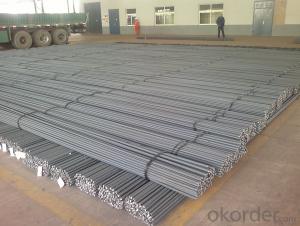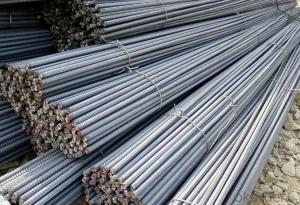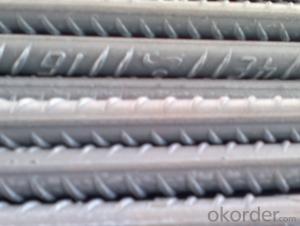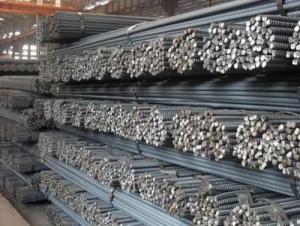Steel Rebar, Deformed Steel Bar, Iron Rods for Construction or Concrete
- Loading Port:
- Tianjin
- Payment Terms:
- TT OR LC
- Min Order Qty:
- 24 m.t.
- Supply Capability:
- 23000 m.t./month
OKorder Service Pledge
OKorder Financial Service
You Might Also Like
REINFORCING DEFORMED STEEL BAR
ACORDING TO ASTM/BS/FEE/ EXTC....
LENGTH:ANY LENGTH
PLEASE SEND US YOUR REQUEST WITH FULL DETAILS FOR BEST OFFER
REINFORCING DEFORMED STEEL BAR
ACORDING TO ASTM/BS/FEE/ EXTC....
LENGTH:ANY LENGTH
Specifications
Certificates: CE & ISO9001:2000
Material: hrhrb400 ,hrb500, BS4449, ASTM A615, SD400
length:6-12
Size: 6mm-40mm
HRB 400E Hot rolled steel rebar
Type | steel rebar |
Standard Grade | a. GB1499.2-2007, HRB335, HRB400E, etc. |
b. ASTM A615 Gr.40, Gr.60, etc. | |
c. BS4449/1997, etc. | |
Diameter | 6mm-32mm etc. |
Length | 6m, 8m, 9m,12m as standard |
Application | construction industry with all types of reinforced concrete structures and so on |
Packing | standard export packing, or as per customers' requirement |
Quality | First quality |
Delivery time | Right now after the deposit. |
Others | 1. all the production process are made under the ISO 9001:2001 strictly |
2. our products conform to all the standards | |
3. we can offer special specification products as per our customers |
We are willing to establish long business relations with customers all over the world. Any comments and requirement will be appreciated. It is our big pleasure of serving you.
If you are interested in our products, please contact us for more information we can supply you with competitive price and good service.
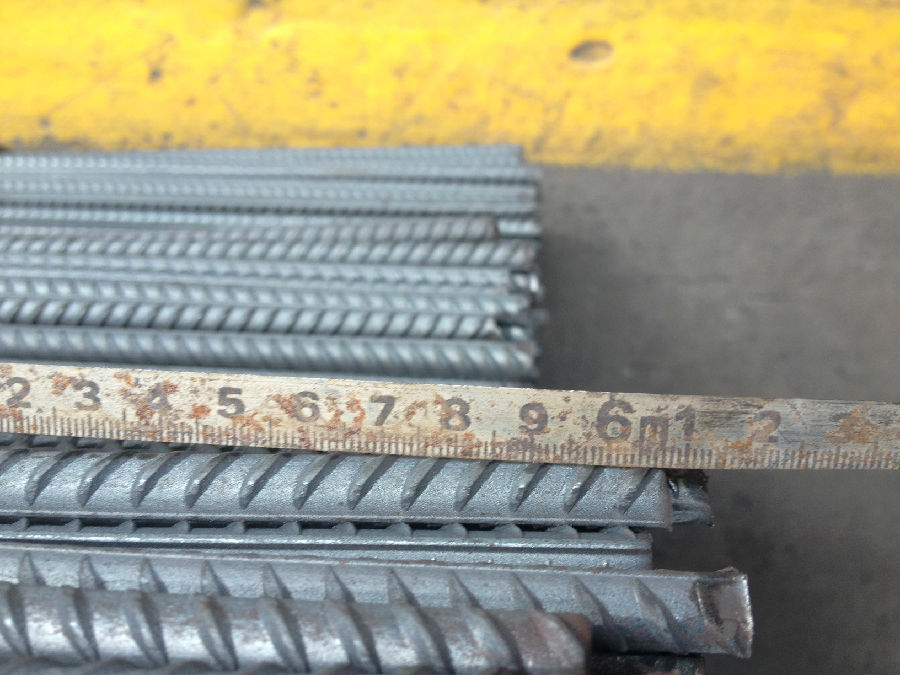

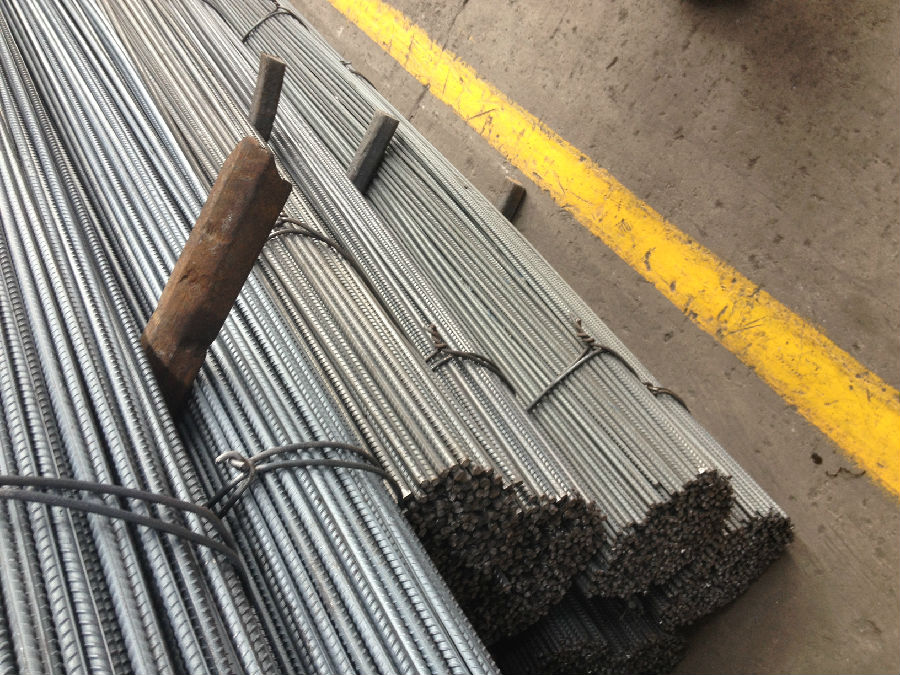
- Q:How do steel rebars affect the overall crack resistance of concrete structures?
- Steel rebars significantly improve the crack resistance of concrete structures. By reinforcing the concrete, rebars help distribute and absorb tensile forces, preventing the formation and propagation of cracks. This reinforcement enhances the overall strength and durability of the concrete, making the structure more resistant to cracking under various loads and environmental conditions.
- Q:What is the standard diameter of steel rebars?
- Steel rebars usually have a standard diameter that falls between 6 millimeters and 50 millimeters. The most frequently used diameters are 10 millimeters, 12 millimeters, 16 millimeters, and 20 millimeters. The choice of a particular diameter for a steel rebar depends on the specific application and the structural demands of the construction project. These rebars are commonly employed in reinforced concrete structures to bolster their tensile strength and overall endurance.
- Q:Can steel rebars be used in structures with heavy dynamic loads?
- Structures with heavy dynamic loads can indeed make use of steel rebars. In reinforced concrete structures, steel rebars are commonly employed to enhance tensile strength and improve overall structural integrity. Their specific design enables them to withstand heavy loads, including dynamic ones caused by vibrations, earthquakes, or moving vehicles. The remarkable tensile strength of steel rebars allows for effective absorption and distribution of dynamic loads, effectively preventing structural failure or collapse. Moreover, steel rebars exhibit exceptional resistance to fatigue, thereby maintaining their strength and integrity even under repeated loading and unloading cycles. To ensure optimal performance under heavy dynamic loads, engineers take into account various factors, such as the size, shape, and spacing of rebars, as well as the quality of the concrete and the design of the structure itself. By meticulously designing and reinforcing the structure with steel rebars, it becomes possible to create a building that is both safe and durable, capable of withstanding heavy dynamic loads.
- Q:How do steel rebars help in load distribution within a structure?
- Steel rebars, also referred to as reinforcing bars, are essential for the distribution of loads within a structure. They are extensively utilized in concrete structures, like buildings, bridges, and highways, to enhance their strength and durability. The main objective of steel rebars is to provide tensile strength to the concrete. While concrete is highly capable of withstanding compression, it is relatively frail when it comes to tension. Any structure exposed to loads, whether from the weight of the building itself or external forces, will encounter both compression and tension forces. By incorporating steel rebars into the concrete, they act as reinforcements and resist tensile forces. When an external load is applied to the structure, the rebars bear a significant portion of the generated tension forces. This prevents the concrete from cracking or failing under the applied load. Furthermore, steel rebars aid in the distribution of the load throughout the structure. When a load is imposed on a structure, it generates stress that is spread across the various components. The presence of rebars enables a more uniform distribution of these stresses, reducing the concentration of forces in specific areas. This prevents localized failures and ensures that the load is evenly dispersed across the structure, thereby improving its overall strength and stability. Another crucial aspect of steel rebars is their capacity to bond with concrete. The rough surface of the rebars prevents them from slipping or separating from the concrete, ensuring a robust bond between the two materials. This bond further enhances the distribution of loads by enabling the rebars to effectively transfer the tensile forces to the surrounding concrete. In conclusion, steel rebars play a critical role in the distribution of loads within a structure. They furnish the necessary tensile strength to withstand tension forces, distribute the load evenly across the structure, and bond with the concrete, guaranteeing a sturdy and stable construction. Without steel rebars, concrete structures would be considerably weaker and more prone to cracking or failure under load.
- Q:Are steel rebars subject to any international standards or regulations?
- Yes, steel rebars are subject to international standards and regulations. The most widely recognized standard for steel rebars is the ASTM A615/A615M-20, which provides specifications for deformed and plain carbon-steel bars for concrete reinforcement. Additionally, various countries and regions may have their own specific standards and regulations regarding the production, testing, and use of steel rebars to ensure their quality and performance in construction projects.
- Q:What are the different methods for attaching steel rebars to existing structures?
- There are several methods for attaching steel rebars to existing structures, depending on the specific requirements and conditions of the project. Some common methods include: 1. Welding: This method involves using welding techniques to attach the rebars to the existing structure. It provides a strong and durable connection, but it requires skilled labor and may not be suitable for all situations. 2. Epoxy bonding: Epoxy adhesives can be used to bond rebars to existing structures. This method is easy to apply and provides a reliable connection, especially when the rebars are embedded in concrete. However, it is important to ensure proper surface preparation and follow manufacturer's instructions for best results. 3. Mechanical anchoring: Mechanical anchors, such as anchor bolts or expansion anchors, can be used to attach rebars to existing structures. This method involves drilling holes into the structure and inserting the anchor, which provides a secure connection. It is important to select the appropriate anchor type and size based on the load requirements and structural conditions. 4. Clamping or fastening: In some cases, rebars can be attached to existing structures using clamps or fasteners. This method is relatively quick and easy to install, but it may not provide as strong of a connection as welding or epoxy bonding. 5. Overlapping: When reinforcing existing concrete structures, rebars can be overlapped with the existing reinforcement and tied together using wire or other methods. This method is commonly used in construction to ensure continuity of reinforcement and increase the load-carrying capacity. It is important to consult with structural engineers or professionals with expertise in rebar installation to determine the most suitable method for attaching steel rebars to existing structures. They will consider factors such as structural integrity, load requirements, and local building codes to ensure a safe and effective connection.
- Q:How do steel rebars prevent corrosion in concrete structures?
- Steel rebars prevent corrosion in concrete structures through the process of passivation. Passivation is the formation of a thin, protective oxide layer on the surface of the steel rebar, which acts as a barrier against corrosion-causing agents. When steel rebars are embedded in concrete, the alkaline environment created by the cement paste helps in passivating the steel. The high pH level of the concrete creates a protective layer of iron oxide (rust) on the rebar's surface, preventing the steel from coming into contact with moisture and oxygen. Furthermore, the dense and impermeable nature of well-constructed concrete limits the movement of water and other corrosive substances towards the steel rebars. This reduces the likelihood of corrosion initiation and its progression. In addition to the alkaline environment and concrete's impermeability, steel rebars are also typically coated with a layer of epoxy or zinc to provide an extra layer of protection. These coatings further enhance the resistance of the steel to corrosion, particularly in aggressive environments such as marine or chloride-rich conditions. Regular maintenance and preventive measures, such as ensuring proper concrete cover over the rebars and avoiding the presence of excessive moisture or chloride ions, also play a crucial role in preventing corrosion in concrete structures.
- Q:What is the process of inspecting steel rebars on-site?
- The process of inspecting steel rebars on-site involves several steps to ensure the quality and adherence to specifications. 1. Visual Inspection: The inspector starts by visually examining the rebars for any visible defects or damage, such as rust, cracks, bends, or improper dimensions. This helps identify any immediate issues that need attention. 2. Measurement: Accurate measurements are crucial to ensure the rebars meet the required dimensions. Using tools like calipers or measuring tapes, the inspector checks the length, diameter, and shape of each rebar, comparing them against the project specifications. 3. Chemical Analysis: Some projects may require chemical analysis of the steel rebars to confirm their composition and strength. Samples are taken from different batches of rebars and sent to a lab for testing. The results determine whether the rebars meet the required standards. 4. Non-Destructive Testing (NDT): NDT techniques are employed to evaluate the internal integrity of the rebars without damaging them. Methods like ultrasonic testing, magnetic particle inspection, or radiography are used to detect any hidden defects such as cracks, voids, or inclusions. 5. Weld Inspection: If welding is involved, the inspector checks the welds for proper penetration, alignment, and quality. This ensures the integrity and strength of the joint. 6. Documentation: Throughout the inspection process, the inspector maintains detailed records of the inspections conducted, measurements taken, test results, and any identified defects. These documents serve as evidence of compliance and can be referred to in case of disputes or future reference. 7. Reporting and Communication: After completing the inspection, the inspector prepares a detailed report summarizing the findings. This report is shared with the project management team, engineers, and other relevant stakeholders, highlighting any non-compliance, defects, or areas that need attention. Overall, the process of inspecting steel rebars on-site is a comprehensive and systematic approach that ensures the quality, integrity, and compliance of the rebars with the project specifications and industry standards.
- Q:Can steel rebars be used in the construction of museums and cultural centers?
- Yes, steel rebars can be used in the construction of museums and cultural centers. Steel rebars provide structural reinforcement and are commonly used in concrete construction. They help to strengthen the concrete and enhance its durability, making them suitable for the construction of buildings that require long-term stability and protection of valuable artifacts or cultural exhibits.
- Q:What is the weight of steel rebars per meter or foot?
- The weight of steel rebars per meter or foot can vary depending on the size and type of rebar being used. On average, a mild steel rebar typically weighs around 0.44 pounds per foot or 0.67 kilograms per meter. However, it is important to note that different rebar sizes and compositions can result in different weights.
1. Manufacturer Overview |
|
|---|---|
| Location | |
| Year Established | |
| Annual Output Value | |
| Main Markets | |
| Company Certifications | |
2. Manufacturer Certificates |
|
|---|---|
| a) Certification Name | |
| Range | |
| Reference | |
| Validity Period | |
3. Manufacturer Capability |
|
|---|---|
| a)Trade Capacity | |
| Nearest Port | |
| Export Percentage | |
| No.of Employees in Trade Department | |
| Language Spoken: | |
| b)Factory Information | |
| Factory Size: | |
| No. of Production Lines | |
| Contract Manufacturing | |
| Product Price Range | |
Send your message to us
Steel Rebar, Deformed Steel Bar, Iron Rods for Construction or Concrete
- Loading Port:
- Tianjin
- Payment Terms:
- TT OR LC
- Min Order Qty:
- 24 m.t.
- Supply Capability:
- 23000 m.t./month
OKorder Service Pledge
OKorder Financial Service
Similar products
New products
Hot products
Hot Searches
Related keywords
